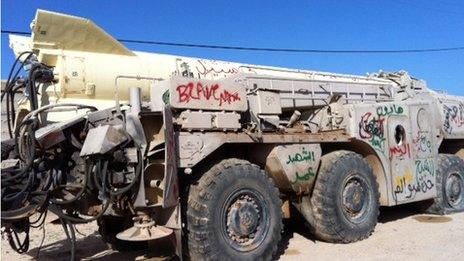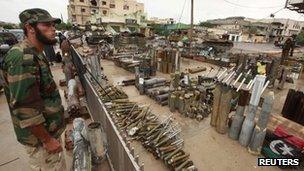On the trail of Libya's missing missiles
- Published

Abandoned by the side of the road - a Scud transport and delivery system
"Scud," he thunders, pointing at a large projectile mounted on a truck.
Colonel Mohammed Amer, a commander with one of the "revolutionary" brigades that helped to topple Colonel Muammar Gaddafi, shows off his war trophy at a military camp near Misrata.
He explains this was one of 13 Scuds that Gaddafi planned to use on his people.
It is a crude, imprecise weapon capable of inflicting damage on a target up to 300km (190 miles) away.
This one was seized from the desert in Bani Walid and brought east to the city of Misrata, where thousands of people lost their lives trying to defend the city between February and May.
But it is not the crude Scuds that are worrying the international community: it's the proliferation of other weapons that have not yet been secured.

Many types of weapons have been left unsecured after the end of fighting in Libya
The interim authority, the National Transitional Council (NTC), has been quick to identify some of the largest weapons sites, especially where chemical weapons - including mustard gas - have been identified.
Even so we found artillery shells, ammunition and more lying unsecured in abandoned warehouses in Tripoli. Now there are concerns that other more deadly weapons are going astray.
For the past two weeks, we have been on the search for so called Manpads - Man Portable Air Defence Systems - a new acronym in Libya's war lexicon. These surface-to-air missiles, which are easy to use and easy to hide, are the weapon of choice for groups like al-Qaeda, say security experts.
We've seen warehouses turned into arsenals, trenches three metres deep once stuffed with weapons, breathing apparatus for chemical respirators, and AK47s everywhere - even children brandishing them.
Videos circulating on the internet during the early days of the eight-month uprising show NTC "liberation fighters" or rebels, posing with a portable surface-to-air missile for the cameras.
Seized from one of Colonel Gaddafi's packed arsenals, the missiles portray a potent symbol of power, not just on the battlefield but in civilian life.
Capable of disabling an aeroplane in a matter of seconds, portable surface-to-air missiles were used in Kenya back in 2002, during a failed attempt to bring an Israeli plane down.
Sense of urgency
Now that the guns are almost silent in Libya, there's a sense of urgency to try to locate the missiles and launchers that may have been looted.
The Americans, who have refused repeated requests to do interviews with our BBC team in Libya, have been briefing widely on the issue elsewhere.
The official line sent in a text message is that "teams on the ground have already disabled or destroyed... over 1,500 Manpads in Libya", adding that they believe many more were destroyed during the Nato campaign.
But we have found the evidence on the ground hard to find.
Human Rights Watch identified surface-to-air missiles discarded at weapons dumps during the final days of fighting. But a month on - and despite NTC assurances that there are attempts at recovery - there is still much confusion.
"There are just a few thousand, not 20,000," insists Fawzi Abu Katif, the deputy defence minister, who concedes that they have no clear idea how many of these weapons are in circulation".
Colonel Gaddafi is believed to have stockpiled up to 20,000 Manpads back in the 1970s, but just how many were sold on to his allies in the intervening years, no-one knows.
International anxiety
And so reports that missiles and ammunition are being smuggled across the border from Tobruk into Egypt and on into Gaza are causing ripples of anxiety throughout the international security community.
The president of neighbouring Niger, Rafini Briji, this week warned that the conflict in Libya had created "very complicated situations since the arms depots were opened and people from all quarters helped themselves and took them in all directions".
A British official, speaking anonymously, admitted they feared there were potentially "thousands" still in circulation.

Some weapons are being recovered and brought to giant arms dumps
The NTC forces have been keen to accommodate us. We've had extraordinary access to weapons sites in both the capital and further east and though we've seen vast quantities of heavy and light weapons, not a single Manpad has been produced.
A well-placed source within the NTC security committee insists the weapons exist and are safe, but are not yet centrally controlled. He warns that the Manpad issue, risks being used to whip up fears, manipulated and used as propaganda.
There is genuine concern that some of these weapons are straying across borders, getting into foreign militants hands, but, he wonders, how much is this threat being overstated by the international community?
With no concrete evidence that Manpads are now safely behind lock and key, and with a government still to be named, Libya is in a precarious place.
The fog of uncertainty needs to be lifted by the authorities who, in so many ways, have been quick to restore order. If not, many fear Libya's new found freedoms, could be exploited.